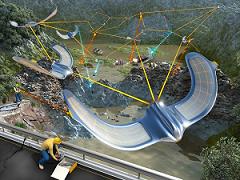
An army of swarming robots could be a key ingredient in saving you after a disaster. The EPFL in Switzerland has developed SMAVNET, a swarm of small flying machines that can establish a wireless communication network to help rescue workers communicate. The micro aerial vehicles (MAVs) look like remote control planes, but they are programmed to fly autonomously. Researchers at EPFL wanted the MAVs to be able to quickly spread out and establish a network even if they didn’t have GPS data, so SMAVNET was taught a trick used by army ants. MAVs paint each other with ‘virtual pheromones’ and use these markers to let them know where they should explore – similar to how ants will locate food and direct others to it. Watch all ten drones of SMAVNET take off and fly in the video below.
Each MAV is designed to be cheap and easily replaceable, sort of like ant drones. The MAVs weigh about 420 grams each, are about 80 cm wide, and have a run time around 30 minutes. They can be deployed by a single operator, so that a rescue worker at a disaster relief site could quickly establish a wireless network and guide the efforts of peers in the field.
Controlling a swarm of robots is usually as difficult as getting them into the air. EPFL used the army ant pheromone inspired approach to allow each drone to establish a new position in the network based only on other drones in the air. In this way, faulty GPS signals wouldn’t interfere with relief efforts. The simulation below explains how drones switch behaviors depending on how often other drones have passed by them and marked them with virtual pheromones.
EPFL also experimented with letting the swarm decide how to deploy itself. Simulations were run that let search programs artificially evolve, with the best being reverse engineered to find useful algorithms:
Establishing a communication network during a rescue effort is important, and swarm robotics seem a natural fit to the challenge. iRobot is even working on a similar swarm network solution for the Army using small WiFi tank bots. Yet I think that long term applications will involve more than just networking. With increased battery life, or decreased power requirements, drones like these could one day incorporate cameras and get directly involved in search efforts (or perform surveillance). One day we could have a flying swarm of drones that seek out and find people in the same way ants hunt for food. …Actually, that sounds rather menacing.
I’m glad these things are on our side.
[image and video credits: EPFL]
[source: EPFL]



